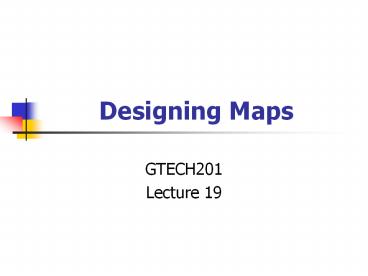Designing Maps - PowerPoint PPT Presentation
Title:
Designing Maps
Description:
Designing Maps GTECH201 Lecture 19 Yet Another Definition A graphic depiction of all or part of a geographic realm in which the real-world features have been ... – PowerPoint PPT presentation
Number of Views:209
Avg rating:3.0/5.0
Title: Designing Maps
1
Designing Maps
- GTECH201
- Lecture 19
2
Yet Another Definition
- A graphic depiction of all or part of a
geographic realm in which the real-world features
have been replaced by symbols in their correct
spatial location at a reduced scale.
3
Cartographic Design Principles
- Audience and purpose
- Size, scale, and media
- Visual balance
4
Audience and Purpose
5
Size, Scale and Media
6
Visual Balance
7
Elements of a Map
- Map body
- Legend
- Title
- Scale
- North arrow
- (inset map)
8
(No Transcript)
9
Other Elements of a Map
- Source of data
- Map projection
- Author
- Date
- Neatline
- Graphs, tables, images, informative text
- ..leading towards a poster
10
(No Transcript)
11
Who Made It?
UTM??
What is its name?
Coordinates in DD
Legend
Where is it located (inset)?
Border
Where is north
Neatline?
What is the scale/
- Credits.
- How was it made.
- Projection and Datum.
- Other metadata
How accurate is it and where can you get it?
12
Map Templates
13
Layer Transparency
14
Labels and Annotation
- ..more later today
15
Reference System
- Graticule ºN/S, ºE/W
- Measured grid X, Y
- Reference grid 12B or 14G
16
Map Layout
- Templates again
17
Map Scale
- The ratio of the distance between two points on
the map and the distance between the same two
points in the real world - Describes distances and area sizes
18
Why Do We Care About Scale
- To compare or edge-match maps, they must be in
the same GCS - Remember, a GCS consists of
- A metric
- An origin
- A projection
- A datum
19
Types of Scale
- Graphical
- Phrase (word(y) statement)
- Representative fraction
- Special cases
- Variable scale
20
Graphical Scale
- Changes in map size(copy machine) preserve scale
relationships - Unit independent
21
Verbal Scale
- Does not preserve scale with size change
- Unit-dependant
- One inch equals one mile
- One to a a mile
22
Representative Fraction
- Does not preserve scale in size change
- Unit independent
- Ratio is true regardless of units
- Expressed as a ratio 1100,000
- Expressed as a fraction 1/100,000
23
Variable Scale
- Projections that do not preserve distance
- City maps (Falk)
24
Large vs. Small Scale
- Small scale shows large areas
- Large denominator
- Think of it as small in detail
- Large scale shows small areas
- Small denominator
- Think of it as large in detail
1/500,000
1/500
25
Area and Scale
- Retains the same relationship as linear scale
- The linear scale is squared
- 11,0002 equals 11,000,000
- One square inch to one square mile
26
Examples of Scale
27
You Have to Decide
- What is the intended use
- How will it be used
- How much detail
- What are the units
28
Linear Units
- Metric
- Kilo-, centi-, milli-meters
- SAE
- Miles, yards, feet, inches
- Other
- Degrees, chains, furlongs, rods, light-years
- Unit-less
29
Areal Units
- Metric
- Hectare, decare, are
- U.S. Public Land Survey
- Township, section, acre
- Other
- City block, ZIP code, police district, parsec
- Unit-less
30
Convenient Fractions
- Metric
- 1 / 100,000 or 1 cm equals 1 km
- SAE
- 1 / 63,360 or 1 inch equals 1 mile
- U.S. topographic maps
- 1 / 24,000 or 1 inch equals 2,000 feet
31
Metric / SAE Conversion
League 1
Mile 3
Furlong 24
Chain 240
Rod 960
Yard 5280
Foot 15,840
Link 24,000
Hand 47,520
Inch 190,100
Line 2,281,000
Kilometer 4.828
Meter 4,828
Centimeter 482,800
Millimeter 4,828,000
32
Beware of
- 1 / 100,000 does NOT mean
- 1 mm equals 1 km, or
- 1 inch equals 100,000 feet
- Mixed units
- Not allowed in representative fractions
- Permitted in verbal usage
33
Resolution
- What is it that you wish to represent
- Countries
- States
- Counties
- Towns
- Property ownership
34
Detail
- How much information needs to be conveyed?
- How precisely have objects to be mapped?
- Generalization
- Cartographic license
35
Cartographic License
- Alteration of real-world spatial relations to
better present pertinent information - Distortion
- Combination
- Shift
- Exaggeration
36
How Much Detail?
37
Road Displacement
38
Generalization
- 15,000
- 110,000































